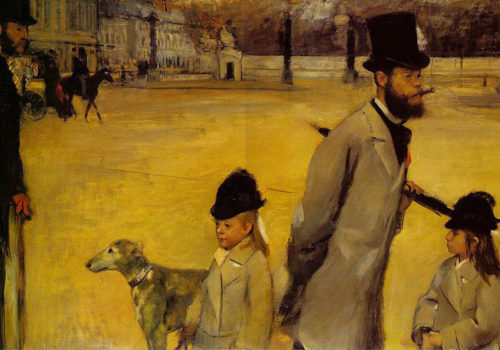The magnificent exhibition dedicated to Fromanger, on view at the Centre Georges Pompidou in Paris until May 16th, 2016, is an opportunity to reflect on the ambiguous relationship between photography and painting over the last several decades, and to consider the centrality of this issue in much of Gérard Fromanger’s work.
Since Impressionism, and in particular since Degas, the photographic image has often informed the production of painters seeking to convey in their work the instantaneity and the documentary quality of photography.
Gérard Fromanger belongs to the so-called Narrative Figuration movement, founded in the 1960s by a group of painters who took advantage of photography by painting over an image projected onto canvas. For the most part, they rejected all forms of subjective expressivity typical of painting in order to replace it with photographic objectivity, thereby concentrating on the message, be it political, poetic, or aesthetic.
Fromanger’s series Boulevard des Italiens (1971) perfectly exemplifies this philosophy: the artist commissioned a photographer to produce a series of images at lunch hour in one of the Parisian “grand boulevards.” He then proceeded to make a selection that would constitute a series, and projected each image onto a canvas in order to paint each cityscape in shades of a different color. Fromanger used intense solid red to bring out the figures of anonymous passersby captured by the photographer. These red silhouettes remind us that “this is not a photograph,” despite the resemblance between the painting and a photographic image. These figures assert themselves in their two-dimensionality and their temporal neutrality, since there isn’t a single detail that would allow us to identify them: the Parisian landscape has aged (this is the 70s) while the red silhouettes are as fresh as ever.
In the next series, Le peintre et son modèle (1972), Fromanger sends a clear message in this subtle interplay intended to blur the spatiotemporal relationship between photography and painting. This picture represents a cityscape with the silhouette of the artist painted on the right-hand side in solid black (the painter’s shadow!). The artist seems to be looking at three photographs, pinned to the wall, of a female nude in provocative poses, advertising an erotic show at a club in the Pigalle district. With the theme of the series, The Painter and his Model, Fromanger affirms that he is a painter and that his work belongs to a pictorial tradition passed down through the centuries; at the same time, the photographic quality of the paintings in this series suggests the contrary by evoking street photography, documentary images, and a social reality indicative of the decline of our civilization where the painter’s (or the photographer’s!) model is to be found in strip-clubs, shop windows, or on the sidewalk across the street from an art gallery.
The relationship between the painter and the photographic document becomes the main theme of another large-format painting, La vie d’artiste (1975–1977), showing the artist at work in his atelier, projecting onto a canvas the photographic image that is the subject of his next painting: a prison riot. It is a sort of mise-en-abime with the photo projected onto the canvas. Bright-colored lines crisscross the whole composition, as if to reaffirm that this is a painting; however, it is a painting of a painting representing a painting of a photograph!
Fromanger ended up rejecting the use of photography as a go-between in favor of the objectivity of the pictorial discourse. In his immense painting De toutes les couleurs, peinture d’histoire (1991–1992), he uses only solid colors, and yet manages to eloquently maintain the privileged relationship to the document, information, and the complexity of the modern world.
Fromanger’s most recent painting presented at the Centre Pompidou, Peinture-monde, Carbon black is dated 2015. In the lower portion of the canvas, it features a lifeboat crammed with silhouettes painted in bright, solid colors, and, above, other, identically colored silhouettes representing walkers, presumably city-dwellers out for a stroll on a cloudless Sunday. All these figures appear against a “carbon black” background. The message needs no photographic “filter” to speak loud and clear.
EXHIBITION
Gérard Fromanger
From February 17th to May 16th, 2016
Centre Pompidou
Place Georges-Pompidou
75004 Paris
France
https://www.centrepompidou.fr
















